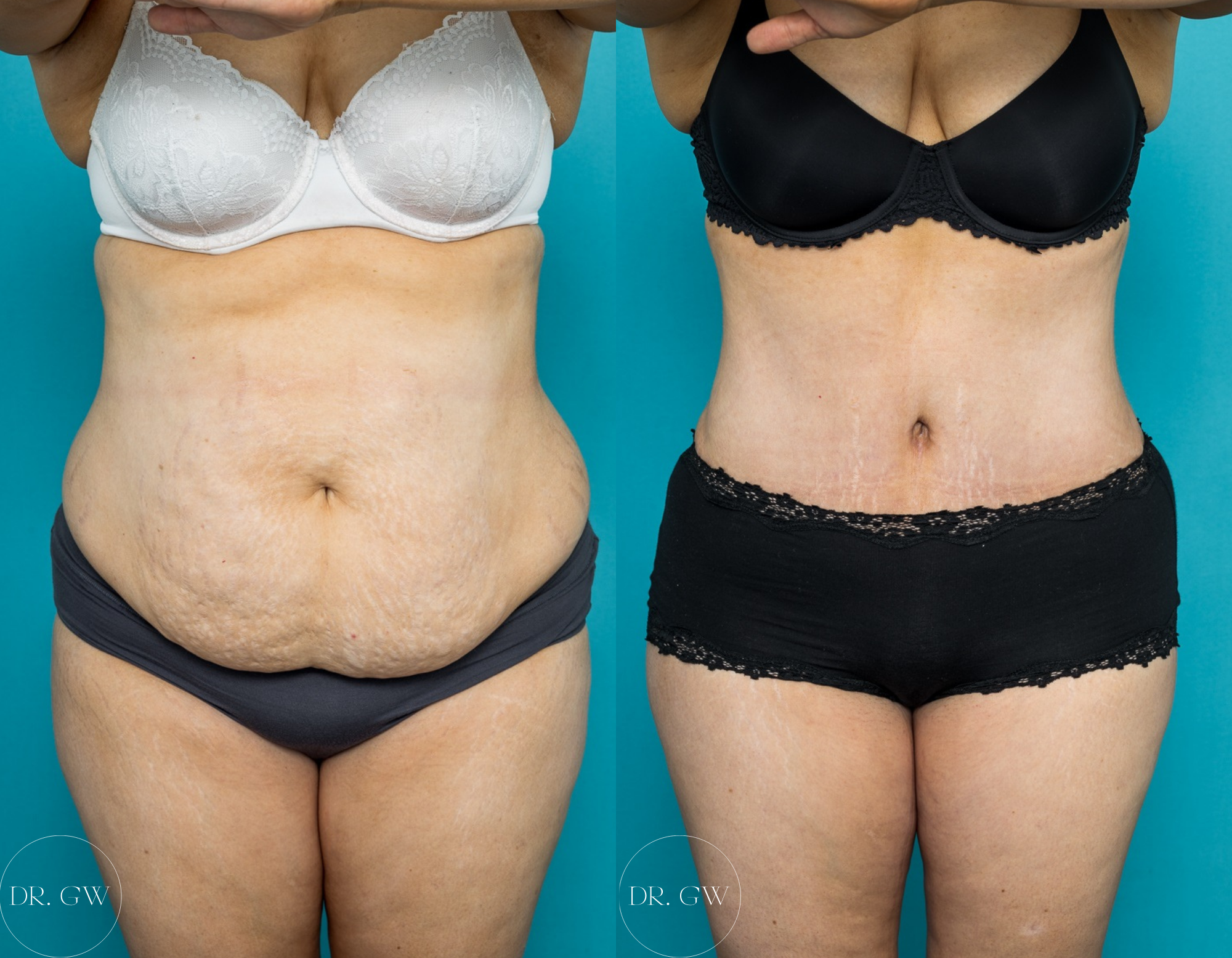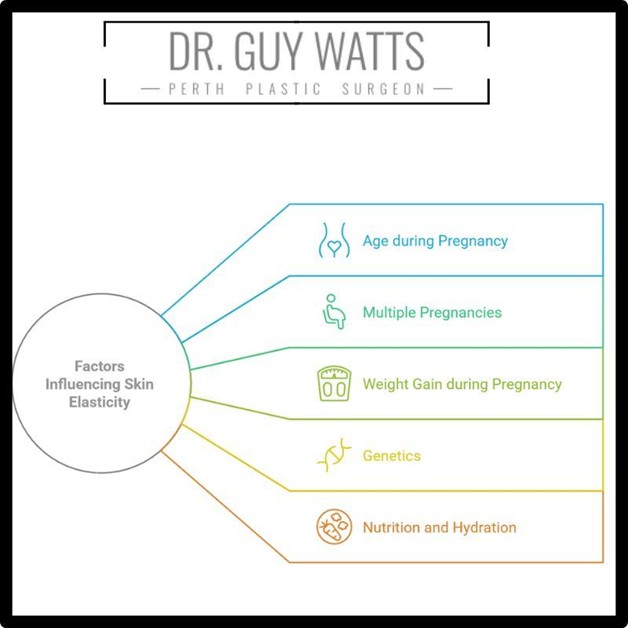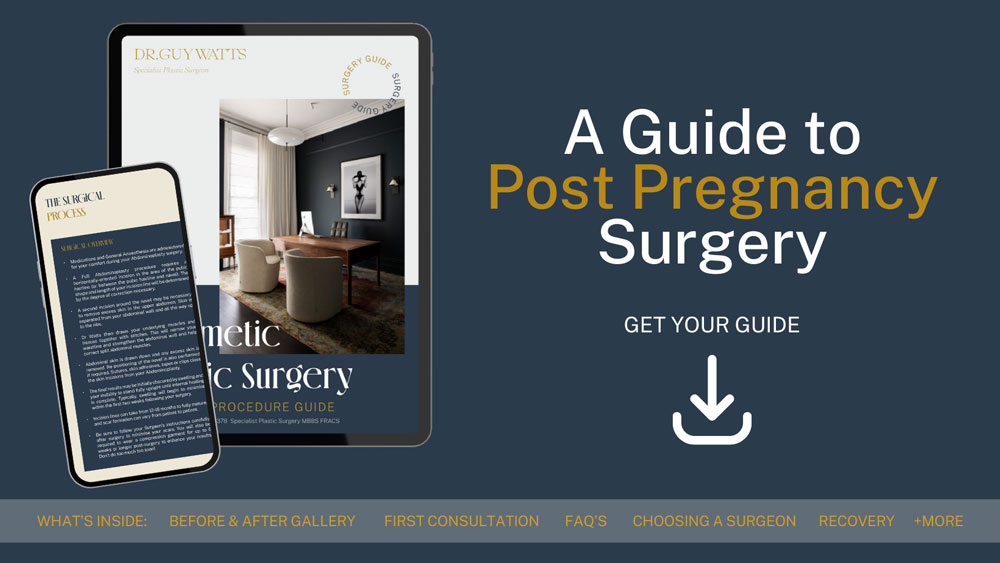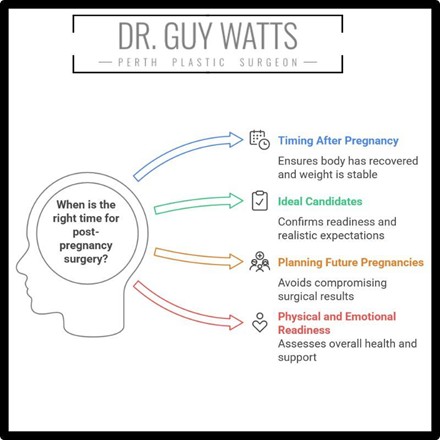
06 Jul Treating Loose Skin after Pregnancy – Causes and Options
Options to Manage Excess Loose Skin after Pregnancy
Your body has undergone an extraordinary transformation to accommodate your growing baby, and your skin, in particular, has stretched significantly over nine months. For some women, this can result in loose, sagging skin, particularly around the abdomen, and it may not bounce back as quickly as you’d hope.
Perth Specialist Plastic Surgeon Dr. Guy Watts explores why loose skin occurs after pregnancy, what factors influence its severity, and most importantly, what treatments are available to you – from natural remedies to surgical interventions. We’ll discuss realistic expectations and timing considerations.
Take our quiz, and find out if you are ready for surgery
Why Loose Skin Occurs Post-Pregnancy
During pregnancy, your skin stretches gradually to accommodate your growing baby. This stretching occurs primarily in the abdomen but can affect other areas such as the breasts, thighs, and hips. The medical term for this stretching is ‘skin laxity’, and it occurs when the dermis (the deeper layer of skin) stretches beyond its natural elasticity limits.
Your skin is remarkably elastic, thanks to proteins called collagen and elastin. These proteins work together like a rubber band, allowing the skin to stretch and then retract. However, when the skin stretches significantly over a prolonged period, as it does during pregnancy, these proteins can become damaged or weakened. This results in loose, excess skin that may not return to its pre-pregnancy state without intervention.
The most noticeable areas affected by post-pregnancy loose skin typically include:
- The lower abdomen (particularly below the belly button)
- The breasts, especially after breastfeeding
- Upper arms
- Inner thighs
- Hips and love handles
- Lower back
Factors Influencing Skin Elasticity During and After Pregnancy
Several factors determine how your skin responds to pregnancy and its ability to retract afterwards.

✓ Age during Pregnancy
Your age plays a role in skin elasticity. Younger skin typically contains more collagen and elastin, making it more resilient and better able to bounce back after stretching. Women who become pregnant in their early twenties often experience better natural skin retraction compared to those who have children later in life. However, this isn’t a hard and fast rule, as other factors also play crucial roles.
✓ Multiple Pregnancies
Each pregnancy can have a cumulative effect on your skin’s elasticity. With each subsequent pregnancy, the skin stretches further, and its ability to retract naturally may diminish. This is particularly true if pregnancies occur close together, giving the skin little time to recover between each stretching period.
✓ Weight Gain during Pregnancy
While some weight gain is necessary and healthy during pregnancy, excessive weight gain can lead to more pronounced skin stretching. The recommended weight gain during pregnancy varies based on your pre-pregnancy BMI, but generally ranges from 11.5 to 16 kilograms for women with a healthy pre-pregnancy weight. Gaining significantly more than this can result in more severe skin laxity post-pregnancy.
✓ Genetics
Your genetic makeup influences how your skin responds to stretching and its ability to retract. Some women naturally have more elastic skin that bounces back more readily after pregnancy. Others may have genetically less elastic skin that’s more prone to laxity.
✓ Nutrition and Hydration
The foods you eat and your hydration levels play a role in skin health. A diet rich in:
- Protein (for collagen production)
- Vitamin C (for collagen synthesis)
- Vitamin E (for skin healing)
- Zinc (for skin repair)
- Omega-3 fatty acids (for skin elasticity)
can support your skin’s health during and after pregnancy.
DOWNLOAD DR WATTS’ ULTIMATE GUIDE TO POST PREGNANCY SURGERY

Natural Recovery Process after Pregnancy
Being aware of the natural recovery process after pregnancy helps set realistic expectations for your postpartum journey. You should keep in mind that the body needs time to heal and adjust after pregnancy, and this process can’t be rushed.
Timeline for Natural Skin Retraction
The initial postpartum period (first 6-8 weeks) typically sees the most dramatic changes in your body. During this time, your uterus contracts back to its normal size, and you’ll lose a significant amount of pregnancy weight, including fluid retention. However, skin retraction follows a different timeline:
- 0-8 weeks: Initial shrinking as pregnancy hormones decrease
- 3-6 months: Gradual improvement in skin elasticity
- 6-12 months: Maximum natural skin retraction usually achieved
- Beyond 12 months: Any remaining loose skin is unlikely to improve significantly without intervention
Hormonal influences play a role during this recovery period. During pregnancy, your body produces hormones that help soften connective tissue, allowing your body to accommodate your growing baby. These hormone levels gradually return to normal after delivery, which can affect how your skin recovers.
What to Expect During Natural Recovery
It’s important to understand that natural recovery varies significantly from person to person. Some women may see their skin return to near pre-pregnancy condition within months, while others may experience permanent changes. The degree of improvement often depends on:
- The amount of stretching during pregnancy
- Your skin’s natural elasticity
- Your age and genetic factors
- Your postpartum care routine
- Whether you’re breastfeeding (which can affect hormone levels)
- Your overall health and lifestyle habits
During the natural recovery process, you might notice:
- Initial loose, crepe-paper-like skin texture
- Gradual improvement in skin firmness
- Changes in skin sensation
- Varying degrees of improvement in different body areas
- Stretch marks becoming less prominent (though they typically don’t disappear completely)
Keep in mind that while the skin may tighten somewhat on its own, any significant stretching that has caused the underlying muscles to separate (a condition called diastasis recti) won’t resolve without specific intervention. This is a common concern that Dr. Watts addresses with many of his post-pregnancy patients, as it can affect both the appearance of the abdomen and core strength.
Non-Surgical Solutions for Loose Skin after Pregnancy
Before considering surgical intervention, you can try different non-surgical approaches to improve skin laxity after pregnancy. These methods can be particularly effective when implemented early in the postpartum period or for mild to moderate skin laxity.
✓ Skincare and Topical Treatments
While no cream can completely restore severely stretched skin, certain topical treatments may help improve skin texture and appearance:
- Retinoid-based products to promote collagen production
- Moisturisers rich in vitamin E and hyaluronic acid
- Firming creams containing peptides and antioxidants
- Regular exfoliation to improve skin texture
✓ Exercise and Muscle Toning
A well-planned exercise routine can help improve your overall body contour and provide some benefit to skin appearance:
- Core-strengthening exercises to improve abdominal muscle tone
- Strength training to build underlying muscle mass
- Regular cardiovascular exercise to maintain healthy body weight
- Specific postpartum exercises designed to address diastasis recti
✓ Non-Invasive Treatments
Several clinical treatments can help improve skin texture and tightness without surgery:
- Radiofrequency treatments to stimulate collagen production
- Ultrasound therapy for skin tightening
- LED light therapy for skin health
- Medical-grade skin needling
✓ Compression Garments
Wearing compression garments during the early postpartum period may help support loose skin and underlying muscles:
- Medical-grade compression wear
- Postpartum recovery belts
- Supportive undergarments
- Compression leggings
These non-surgical solutions can provide noticeable improvements, but they typically work best for:
- Women with mild to moderate skin laxity
- Those who are within their healthy weight range
- Patients who start treatment early in their postpartum journey
- Those with good skin elasticity
- Younger patients
It’s important to maintain realistic expectations about what non-surgical treatments can achieve. While they can improve skin quality and appearance, they may not completely resolve significant skin laxity or muscle separation.
Surgical Solutions for Loose Skin after Pregnancy
For some women, surgical intervention provides the most effective and long-lasting solution for post-pregnancy loose skin. Dr. Watts performs different surgical procedures designed to address the specific concerns of post-pregnancy patients, each tailored to meet individual needs and desired outcomes.
✓ Tummy Tuck (Abdominoplasty)
The full tummy tuck – abdominoplasty remains the gold standard for addressing significant abdominal loose skin and muscle separation after pregnancy. This complex procedure involves:
- Removing excess skin and fat from the lower abdomen
- Repairing separated abdominal muscles (diastasis recti)
- Repositioning the belly button
- Creating a firmer, flatter abdominal contour
The procedure typically takes 2-3 hours under general anaesthesia, with results visible once swelling subsides. If you’re dealing with stubborn post-pregnancy bulging, surgical options for a C-section pouch may be worth exploring.
✓ Body Lift Procedures
Some women may benefit from a body lift procedure, especially if loose skin affects multiple areas. Options include:
- Lower body lift: Addresses the abdomen, hips, and lower back
- Breast lift – mastopexy: Restores breast position and shape after pregnancy and breastfeeding
- Arm lift – brachioplasty: Removes loose skin from the upper arms
- Thigh lift: Addresses inner thigh skin laxity
✓ Combination Procedures
In some cases, combining multiple procedures can be preferred. Common combinations include:
- Tummy tuck – abdominoplasty with breast augmentation and/or lift
- Body lift with liposuction
- Customised combinations based on individual needs
Recovery and Results
Dr. Watts ensures his patients understand the recovery process, which typically involves:
- 1-2 nights hospital stay for major procedures
- 2-4 weeks off work
- 6-8 weeks before returning to strenuous exercise
- Wearing compression garments for several weeks
- Regular follow-up appointments to monitor healing
When to Consider Surgery
Timing is crucial when considering post-pregnancy surgical procedures. Dr. Watts guides his patients through several important considerations to determine the optimal time for surgery.

Timing after Pregnancy
The general recommendation is to wait at least:
- 12 months after childbirth
- 3-6 months after finishing breastfeeding
- Until your weight has stabilised at or near your goal
This waiting period allows:
- Your body to complete its natural recovery
- Hormones to return to pre-pregnancy levels
- Tissue inflammation to resolve
- A clearer assessment of areas requiring attention
Appropriate Candidates for Surgery
The appropriate candidates for post-pregnancy surgery typically:
- Have completed their families
- Maintain a stable, healthy weight
- Are in good overall health
- Don’t smoke or are willing to quit
- Have realistic expectations
- Are emotionally ready for surgery
- Have adequate support during recovery
It is usually recommended to complete your family before undergoing significant surgical procedures. Future pregnancies can:
- Compromise surgical results
- Lead to renewed skin laxity
- Require revision surgery
- Affect muscle repair results
- Create new areas of concern
FAQs about Loose Skin after Pregnancy
Further Reading about Body Procedures
- Read more about Exercise after Post Pregnancy Surgery
- Read more about Belly Bulge After Baby: Is It Diastasis Recti, Abdominal Fat, or Both?
- Read more about Recovery after Post Pregnancy Surgery
About Dr. Guy Watts – MED0001539378
FRACS (Plas) – Specialist Plastic Surgeon In Perth WA
Dr. Guy Watts is a Specialist Plastic Surgeon (AHPRA MED0001539378) with an extensive career that spans across renowned plastic surgery clinics worldwide. His experience has been honed through invaluable experiences at esteemed establishments such as the New York Eye and Ear Infirmary and the renowned Pitanguy Clinic in Brazil.
Having collaborated with the foremost cosmetic plastic surgeons on a global scale, Dr. Watts has chosen to return to Perth after a 17-year journey of intensive training and invaluable professional experience to bring the latest practices and technology in cosmetic plastic surgery to his patients.
Dr. Watts is a Fellow of the Royal Australasian College of Surgeons (FRACS) and a Member of the Australian Society of Plastic Surgeons (ASPS), Australasian Society of Aesthetic Plastic Surgeons (ASAPS) and the International Society of Aesthetic Plastic Surgeons (ISAPS).
Read about the potential Risks and Complications of Surgery
Read the Patient Information and Resources
About CLINISPA
Clinispa is Dr Watts’ bespoke medical clinic performing Cosmetic Aesthetic treatments. At Clinispa, we offer advanced clinical treatments in a luxurious and calming environment, tailored to support your skin’s health and appearance.
Clinispa aesthetic services are performed by Dr Guy Watts’ nursing professionals, who have a passion for and solid understanding of facial aesthetics.
All Clinispa clients are considered individually, with a personalised treatment plan consisting of advanced scientific approaches to cosmetic aesthetics. We incorporate innovative technologies in conjunction with superiorly formulated skin care.
For more information about the full range of Clinispa Aesthetic of Cosmetic Treatments visit the Clinispa website








Sorry, the comment form is closed at this time.